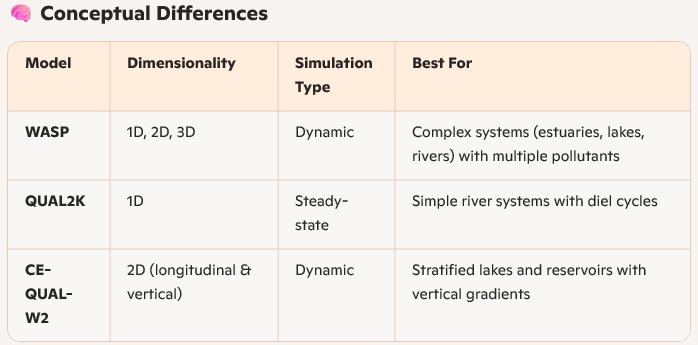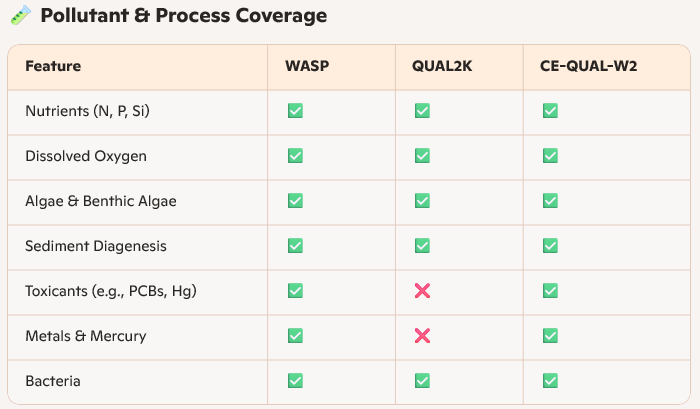🧪 What is WASP?
The Water Quality Analysis Simulation Program (WASP) is a dynamic compartment-modeling tool developed and maintained by the U.S. Environmental Protection Agency (EPA). It helps simulate and predict water quality responses to both natural phenomena and human-induced pollution.
🌊 Key Features
Modeling Dimensions: Supports 1D, 2D, and 3D aquatic systems.
Pollutant Types: Handles conventional pollutants (e.g., nitrogen, phosphorus, dissolved oxygen), organic chemicals, metals, mercury, pathogens, and temperature.
Linked Models: Can integrate with hydrodynamic and sediment transport models for enhanced realism.
Modules:
Advanced Eutrophication: Includes sediment diagenesis to simulate oxygen demand and nutrient fluxes.
Toxic Chemical Dynamics: Models fate and transport of contaminants like PCBs and heavy metals.
🛠️ Applications
TMDL Development: Widely used for Total Maximum Daily Load assessments.
Environmental Impact Studies: Applied to major U.S. estuaries and rivers, including: Delaware River/Estuary, Tampa Bay, FL, Lake Okeechobee, FL, Neuse River Estuary, NC, Potomac Estuary, MD Savannah River, GA
📊 Tools & Interfaces
- Preprocessor: Simplifies data input via spreadsheets or databases.
- Post-Processor (WRDB): Visualizes model predictions with spatial grids and x/y plots for calibration and analysis.
🧑🔬 Intended Users
- Environmental engineers and scientists
- Regulatory agencies
- Researchers in water quality and aquatic systems
📥 Availability
- Current Version: WASP 8.50
- Supported OS: Windows 7+, Mac OSX, Linux (Ubuntu)

🛠️ Integration & Flexibility
- WASP is modular and can link with hydrodynamic models like EFDC for 2D/3D flow simulation.
- QUAL2K uses Excel-based input and is easier to set up but limited to steady-state conditions.
- CE-QUAL-W2 is ideal for vertically stratified systems and has faster run times for long simulations.

🧩 Use Case Scenarios
- WASP: Ideal for modeling eutrophication, toxicant fate, and sediment interactions in complex systems.
- QUAL2K: Great for regulatory snapshots or TMDL development in small rivers.
- CE-QUAL-W2: Best for long/narrow reservoirs with vertical gradients and seasonal dynamics.
WASP Workshop

Tentative Information
- Late Fall (November 2025)
- Location: Atlanta, GA
- Workshop is Open to Everyone
- Free of Charge
- You will need a Notebook Computer for Hands-On Exercises
WASP Tutorials

WASP's YouTube channel is a niche gem for anyone interested in water quality modeling and environmental simulation tools. With over 15 videos and nearly 600 subscribers, the channel dives deep into technical topics like:
🧪 WASP Tutorials: Including command-line usage, model calibration with WRDB Graph, and introductory webinars.
📊 Data Visualization: Workshops and webinars on visualizing model results and using open-source scripts.
🌎 Modeling Applications: Presentations on data needs for watershed modeling and EPA-supported tools.
You can explore the channel on YouTube. If you’re working with WASP or similar tools, it’s a solid resource for practical insights and walkthroughs. Want help summarizing one of his videos or integrating a technique into your own modeling workflow
WASP Listserver

Markdown
Writing in Markdown format is a simple and fast way to add styled text to your web pages.
- Ordered and Unordered Lists.
- Simple Links: Stacks can use Markdown Syntax too.
- Simple formatting: Bold and Italic.
- Code snippets:
10 PRINT "HELLO WORLD"

Markdown
Writing in Markdown format is a simple and fast way to add styled text to your web pages.
- Ordered and Unordered Lists.
- Simple Links: Stacks can use Markdown Syntax too.
- Simple formatting: Bold and Italic.
- Code snippets:
10 PRINT "HELLO WORLD"